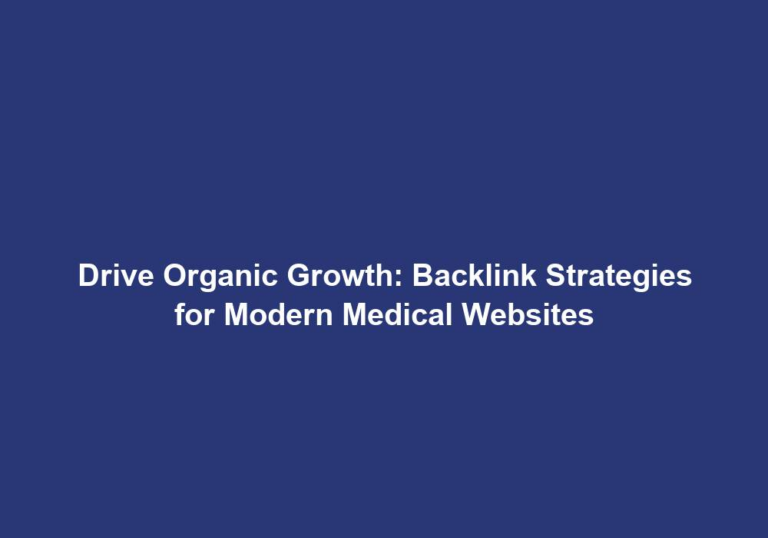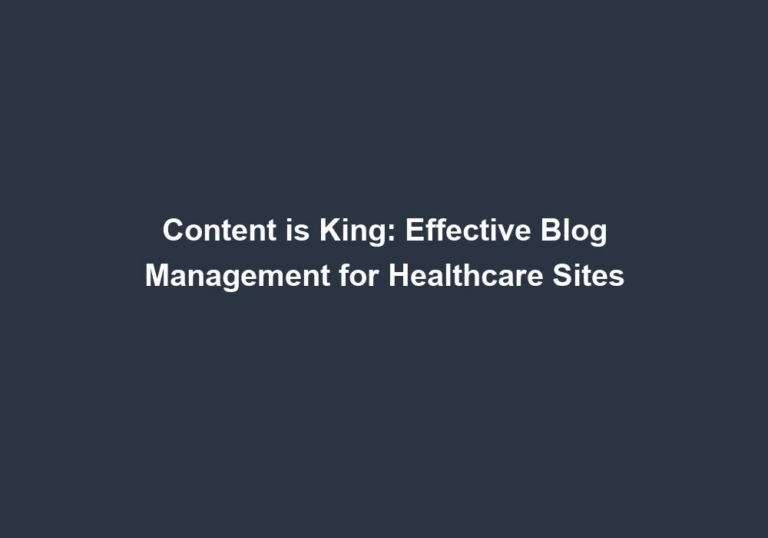Mastering the Basics: Technical SEO for Healthcare Websites
In today’s digital age, having a strong online presence is crucial for healthcare websites to reach a wider audience and attract potential patients. While creating compelling content and engaging with visitors is important, it is equally essential to optimize your website technically to improve its visibility in search engine rankings. This is where technical SEO for healthcare websites comes into play. In this article, we will delve into the fundamental aspects of technical SEO that can help healthcare websites enhance their online performance and ultimately attract more patients.
Understanding Technical SEO
Technical SEO refers to the process of optimizing the technical aspects of a website to enhance its visibility and ranking on search engine result pages (SERPs). It involves improving the website’s infrastructure, code, and server configuration to make it more search engine-friendly. By ensuring proper technical optimization, healthcare websites can improve their chances of ranking higher on search engines like Google, Bing, and Yahoo.
Importance of Technical SEO for Healthcare Websites
Implementing technical SEO strategies can significantly impact the online visibility and success of healthcare websites. Here are some key reasons why mastering the basics of technical SEO is crucial:
-
Improved Search Engine Rankings: Technical SEO helps search engines understand your website better, leading to improved rankings. When your healthcare website ranks higher, it becomes more visible to potential patients searching for relevant healthcare services.
-
Enhanced User Experience: Technical SEO focuses on improving website performance, speed, and overall user experience. A fast-loading and user-friendly website not only keeps visitors engaged but also encourages them to stay longer, explore your website, and potentially convert into patients.
-
Crawlability and Indexability: Technical SEO ensures that search engine bots can effectively crawl and index your website’s pages. This is essential for search engines to understand your content and display it in relevant search results.
-
Mobile Optimization: With the increasing use of smartphones, it is crucial for healthcare websites to be mobile-friendly. Technical SEO helps optimize websites for mobile devices, ensuring a seamless user experience across different screen sizes.
-
Website Security: Implementing technical SEO practices helps protect your healthcare website from security threats. A secure website not only instills trust in visitors but also prevents potential data breaches.
Key Elements of Technical SEO for Healthcare Websites
Now that we understand the importance of technical SEO for healthcare websites, let’s explore the key elements that need to be optimized:
1. Website Speed and Performance
A slow-loading website can lead to high bounce rates and poor user experience. To enhance website speed and performance, consider the following:
- Optimize Images: Compress and resize images without compromising quality to minimize file sizes and improve loading times. This can be done by using tools like ImageOptim or TinyPNG.
- Leverage Browser Caching: Enable browser caching to store static website elements, reducing loading times for returning visitors. This can be achieved by setting cache expiration headers and using caching plugins.
- Minify CSS and JavaScript: Remove unnecessary spaces, line breaks, and comments from CSS and JavaScript files to reduce their size and improve loading speed. Tools like CSSNano and UglifyJS can help with this process.
- Utilize Content Delivery Networks (CDNs): CDNs distribute website content across multiple servers worldwide, reducing server response times and improving user experience. Popular CDNs like Cloudflare and MaxCDN can be integrated with your healthcare website.
2. Mobile-Friendly Design
With the majority of internet users accessing websites through mobile devices, having a responsive design is imperative. Ensure your healthcare website is mobile-friendly by:
- Responsive Design: Implement a responsive design that automatically adjusts the layout and content based on the user’s screen size and device orientation. This can be achieved by using CSS media queries and flexible grid systems like Bootstrap or Foundation.
- Mobile Usability: Optimize font sizes, button sizes, and overall user interface elements to provide a seamless experience on smaller screens. It is important to ensure that buttons and links are easily tappable, text is legible, and the overall design is visually appealing on mobile devices.
- Avoid Flash Content: Flash content is not supported on many mobile devices. Replace it with HTML5 or other mobile-friendly alternatives like CSS animations or JavaScript libraries such as GreenSock.
3. Optimal Website Structure
The structure of your healthcare website plays a crucial role in search engine rankings and user experience. Consider the following tips for a well-structured website:
- Clear and Consistent Navigation: Ensure your website has clear navigation menus that are easy to understand and consistent across all pages. Use descriptive labels for menu items and organize them in a logical hierarchy.
- Logical URL Structure: Use descriptive and keyword-rich URLs that accurately reflect the content of each page. A well-structured URL not only helps users navigate your website but also provides search engines with valuable information about your page’s topic.
- Sitemap Creation: A sitemap helps search engines understand the structure of your website and index it more efficiently. Use XML sitemaps to provide search engines with a comprehensive list of your website’s URLs.
- Internal Linking: Utilize internal links to connect relevant pages within your healthcare website, improving navigation and helping search engines discover more content. Internal linking can also help distribute authority and relevance throughout your website.
4. On-Page SEO Optimization
On-page optimization focuses on optimizing individual web pages to rank higher and attract more organic traffic. Consider the following on-page SEO techniques for your healthcare website:
- Keyword Research: Conduct thorough keyword research to identify the most relevant and high-converting keywords for your healthcare services. Use tools like Google Keyword Planner or SEMrush to discover keywords with high search volume and low competition.
- High-Quality Content: Create informative, engaging, and medically accurate content that provides value to your website visitors. Ensure that your content is well-researched, properly formatted, and includes relevant keywords naturally. Aim for long-form content that covers the topic in-depth.
- Meta Tags Optimization: Optimize meta titles and descriptions using target keywords to improve click-through rates from search engine result pages. Write compelling meta tags that accurately summarize the content of your pages and entice users to click.
- Header Tags: Utilize header tags (H1, H2, H3, etc.) to structure your content and improve readability for both users and search engines. Use header tags to break up your content into logical sections and include relevant keywords in your headings.
- Schema Markup: Implement schema markup to help search engines understand the context and purpose of your content. Schema markup provides additional information about your healthcare services, such as ratings, reviews, and pricing, which can enhance your search engine listings.
5. Website Security and Technical Maintenance
Ensuring the security and technical maintenance of your healthcare website is crucial for both user trust and search engine rankings. Consider the following practices:
- SSL Certificate: Install an SSL certificate to encrypt data transmitted between your users and your website, providing a secure browsing experience. This can be obtained through your hosting provider or through third-party SSL certificate providers.
- Regular Backups: Regularly back up your website to protect against data loss and quickly recover in case of any unforeseen issues. Use backup plugins or services to automate the backup process and store backups securely.
- Fix Broken Links: Regularly check for broken links on your website and promptly fix or redirect them to maintain a seamless user experience. Broken link checker tools can help identify broken links on your website.
- Monitor Website Performance: Regularly monitor your website’s performance through analytics tools to identify and address any technical issues affecting user experience. Pay attention to metrics like page load time, bounce rate, and mobile usability to ensure optimal performance.
Conclusion
Mastering the basics of technical SEO is essential for healthcare websites to improve their online visibility, attract more patients, and ultimately succeed in the digital landscape. By optimizing website speed and performance, ensuring mobile-friendliness, maintaining an optimal website structure, focusing on on-page SEO techniques, and prioritizing website security and technical maintenance, healthcare websites can enhance their search engine rankings and provide an exceptional user experience. So, invest your time and effort in mastering technical SEO practices, and witness the growth of your healthcare website in the online realm.
(Note: This article is written in markdown format and can be easily converted to other formats as needed.)







